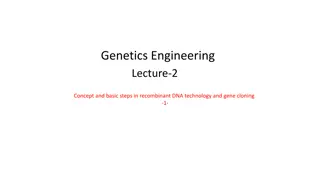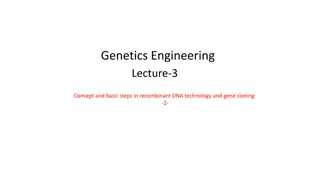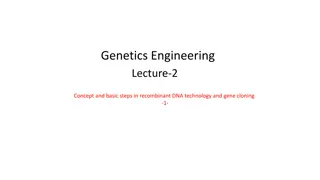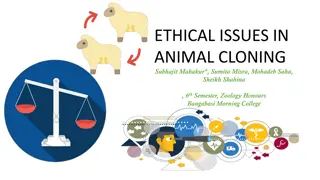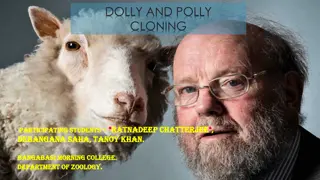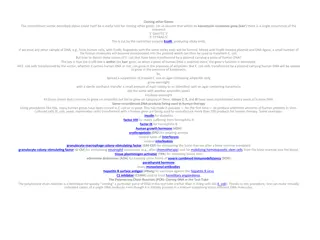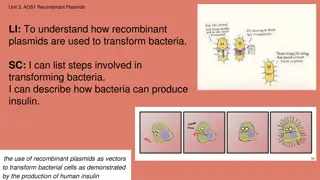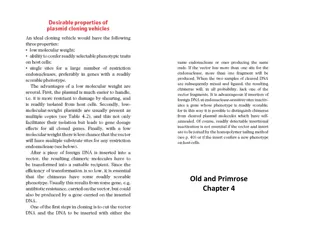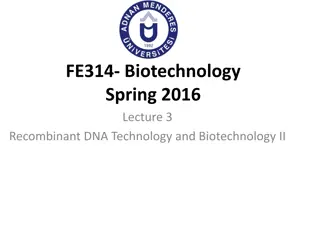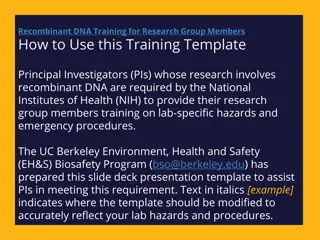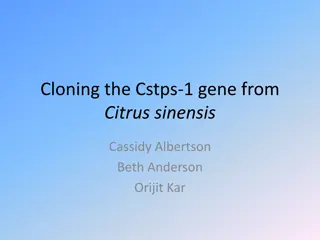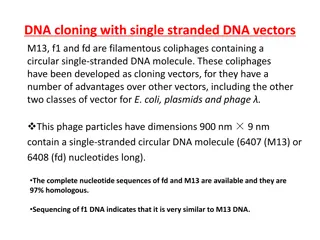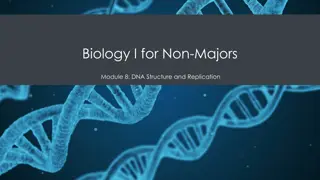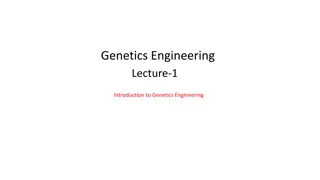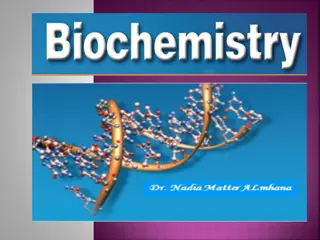Understanding Recombinant DNA and Gene Cloning
Recombinant DNA is artificially created by combining DNA from multiple sources into a single molecule. This process involves treating DNA with restriction endonucleases, such as BamHI, which cut at specific sites, resulting in sticky ends that can base pair with complementary DNA molecules. DNA ligase then covalently links the fragments to form recombinant DNA. Cloning in vivo involves creating identical copies of the recombinant molecule. Cloning can be done in vitro using PCR, but here, we focus on the in vivo process.
Download Presentation

Please find below an Image/Link to download the presentation.
The content on the website is provided AS IS for your information and personal use only. It may not be sold, licensed, or shared on other websites without obtaining consent from the author. Download presentation by click this link. If you encounter any issues during the download, it is possible that the publisher has removed the file from their server.
E N D
Presentation Transcript
Recombinant DNA and Gene Cloning
Recombinant DNA is DNA that has been created artificially. DNA from two or more sources is incorporated into a single recombinant molecule. Making Recombinant DNA (rDNA): An Overview
Treat DNA from both sources with the same restriction endonuclease (BamHI in this case).
BamHI cuts the same site on both molecules
5' GGATCC 3' 3' CCTAGG 5'
The ends of the cut have an overhanging piece of single-stranded DNA.
These are called "sticky ends" because they are able to base pair with any DNA molecule containing the complementary sticky end.
In this case, both DNA preparations have complementary sticky ends and thus can pair with each other when mixed.
a DNA ligase covalently links the two into a molecule of recombinant DNA.
identical copies of the same recombinant molecule is called cloning. Cloning can be done in vitro, by a process called the polymerase chain reaction (PCR). Here, however, we shall examine how cloning is done in vivo.
in mammalian cells grown in tissue culture.
incorporating the DNA in a vector. A number of viruses (both bacterial and of mammalian cells) can serve as vectors. But here let us examine an example of cloning using E. coli as the host and a plasmid as the vector. Plasmids
containing over 4.6 million base pairs encoding approximately 4,300 genes. The small circlets are plasmids. (Courtesy of Huntington Potter and David Dressler, Harvard Medical School.)
Plasmids are molecules of DNA that are found in bacteria separate from the bacterial chromosome.
chromosome. Some plasmids are copied at about the same rate as the chromosome, so a single cell is apt to have only a plasmids are copied at a high rate and a single cell may have 50 or more of them.
of copies are usually expressed at high levels. In nature, these genes often encode proteins (e.g., enzymes) that protect the bacterium from one or more antibiotics.
may account for the rapid spread of antibiotic resistance in hospitals and elsewhere. Plasmids can be deliberately introduced into bacteria in the laboratory transforming the cell with the incoming genes. genes(transfer) and have no characteristic beyond the ability to promote conjugal transfer of plasmids. PLASMID CLASSIFICATION. The most useful classification of naturally occurring plasmids is based on the main characteristic coded by the plasmid genes. The 5 main types of plasmids according to this classification are: Fertility plasmids F : Fertility plasmids carry only tra Resistant R plasmids: They carry genes conferring on the host bacterium resistance to one or more antibacterial agent such as chloramphenicol, ampicillin and mercury. R plasmids are very important in clinical microbiology as they are spread through natural populations and can have profound consequence in the treatment of bacteria infections. Example RP4.
Col plasmids:They code for colicins. These colicins are proteins that kill other bacteria e.g. colE1 of E.Coli.
Degradative plasmids: They allow the host bacterium to metabolise unusual molecules such as Toluene and Salicylic acid e.g. TOL of Plasmodium putida.
Virulence plasmids: These confer pathogenicity on the host bacteriume.g. Ti plasmids of agrobacterium tumefaciens, which induce Crown Gall disease on dicotyledonous plants. An Example: pAMP pKAN Ligation Possibilities Transforming E. coli


